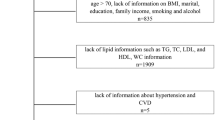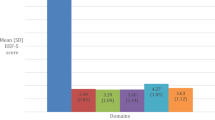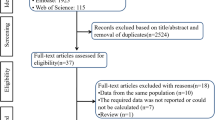Abstract
The aim of this study was to assess the relationship between body fat mass (BFM) and erectile dysfunction (ED) in Korean men. This study was a cross-sectional study using data on 208 men (the mean age=67.4±8.2). ED was diagnosed by the International Index of Erectile Function (IIEF)-5 and body fat percentage (BF%) was quantified with bioelectrical impedance. BF% was divided into quintiles (quintile 1: ⩽20.5%, quintile 2: 20.6–23.2%, quintile 3: 23.3–25.8%, quintile 4: 25.9–28.8%, quintile 5: ⩾28.9%). Using subjects with quintile 3 of BF% as reference, the adjusted odds ratios of subjects with the lowest quintile of BF% and with the highest quintile were 9.29 (95% CI: 2.29–37.72) and 4.99 (95% CI: 1.37–18.09), respectively. This study showed that BFM and ED had a U-shaped relationship in Korean men. These findings suggest that not only obesity but also a low BFM may be a risk factor of ED in Asians.
This is a preview of subscription content, access via your institution
Access options
Subscribe to this journal
Receive 8 print issues and online access
$259.00 per year
only $32.38 per issue
Buy this article
- Purchase on Springer Link
- Instant access to full article PDF
Prices may be subject to local taxes which are calculated during checkout



Similar content being viewed by others
References
NIH Consensus Development Panel on Impotence. NIH Consensus Conference: impotence. JAMA 1993; 270: 83–90.
Litwin MS, Nied RJ, Dhanani N . Health-related quality of life in men with erectile dysfunction. J Gen Intern Med 1998; 13: 159–166.
Feldman HA, Goldstein I, Hatzichristou DG, Krane RJ, McKinlay JB . Impotence and its medical and psychosocial correlates: results of the Massachusetts Male Aging Study. J Urol 1994; 151: 54–61.
Ahn TY, Park JK, Lee SW, Hong JH, Park NC, Kim JJ et al. Prevalence and risk factors for erectile dysfunction in Korean men: Results of an epidemiological study. J Sex Med 2007; 4: 1269–1276.
Feldman HA, Johannes CB, Derby CA, Kleinman KP, Mohr BA, Araujo AB et al. Erectile dysfunction and coronary risk factors: Prospective results from the Massachusetts Male Aging Study. Prev Med 2000; 30: 328–338.
Esposito K, Guugliano F, Di Palo C, Giugliano G, Marfella R, D'Andrea F et al. Effect of lifestyle changes on erectile dysfunction in obese men. JAMA 2004; 291: 2978–2984.
Solomon H, Man JW, Jackson G . Erectile dysfunction and the cardiovascular patient: endothelial dysfunction is the common denominator. Heart 2003; 89: 251–253.
Billups KL . Erectile dysfunction as an early sign of cardiovascular disease. Int J Impot Res 2005; 17: S19–S24.
Jackson G . Vascular risk factors and erectile dysfunction: ‘sexing-up’ the importance of lifestyle changes. Int J Clin Pract 2007; 61: 1421–1422.
Bacon CG, Mittleman MA, Kawachi I, Giovannucci E, Glasser DB, Rimm EB . A prospective study of risk factors for erectile dysfunction. J Urol 2006; 176: 217–221.
Derby CA, Mohr BA, Goldstein I, Feldman HA, Johannes CB, McKinlay JB . Modifiable risk factors and erectile dysfunction: can lifestlye changes modify risk? Urology 2000; 56: 302–306.
Mulhall J, Teloken P, Brock G, Kim E . Obesity, dyslipidemias and erectile dysfunction: a report of a subcommittee of the sexual medicine society of North America. J Sex Med 2006; 3: 778–786.
Chung WS, Sohn JH, Park YY . Is obesity an underlying factor in erectile dysfunction? Eur Urol 1999; 36: 68–70.
Tan JK, Hong CY, Png DJC, Liew LCH, Wong ML . Erectile dysfunction in Singapore: prevalence and its associated factors—A population-based study. Singapore Med J 2003; 44: 20–26.
Cho BL, Kim YS, Choi YS, Hong MH, Seo HG, Lee SY et al. Prevalence and risk factors for erectile dysfunction in primary care: results of a Korean study. Int J Impot Res 2003; 15: 323–328.
WHO/IASO/IOTF. The Asia-Pacific Perspective: Redefining Obesity and its Treatment. Melbourne: Health Communications Australia Pty Ltd, 2000.
Cheng JYW, Ng EML . Body mass index, physical activity and erectile dysfunction: an U-shaped relationship from population-based study. Int J Obes 2007; 31: 1571–1578.
Zamboni M, Mazzali G, Zoico E, Harris TB, Meigs JB, Di Francesco V et al. Health consequences of obesity in the elderly: a review of four unresolved questions. Int J Obes 2005; 29: 1011–1029.
Yesavage JA, Brink TL, Rose TL, Lum O, Huang V, Adey M et al. Development and validation of a geriatric depression screening scale; a preliminary report. J Psychiatr Res 1982–1983; 17: 37–49.
Jung IK, Kwak DI, Shin DK, Lee MS, Lee HS, Kim JY . A reliability and validity study of geriatric depression scale. J Korean Neuropsychiatr Assoc 1997; 36: 103–112.
Rosen RC, Cappelleri JC, Smith MD, Lipsky J, Pena BM . Development and evaluation of an abridged, 5-item version of the International Index of Erectile Function (IIEF-5) as a diagnostic tool for erectile dysfunction. Int J Impot Res 1999; 11: 319–326.
Ahn TY, Lee DS, Kang WC, Hong JH, Kim YS . Validation of an abridged Korean version of the International Index of Erectile Function (IIEF-5) as a diagnostic tool for erectile dysfunction. Korean J Urol 2001; 42: 535–540.
Fung MM, Bettencourt R, Barrett-Connor E . Heart disease risk factors predict erectile dysfunction 25 years later. The Rancho Bernardo Study. J Am Coll Cardiol 2004; 43: 1405–1411.
Jeong DW, Lee SY, Min HG, Kim YJ, Choi SH, Kim YJ et al. Measuring performance evaluation of body fat measuring instrument applying body measuring value method. Korean J Health Promot Dis Prev 2006; 6: 79–87.
Seidell JC, Visscher TLS . Body weight and weight change and their health implications for the elderly. Eur J Clin Nutr 2000; 54: S33–S39.
Matsuo T, Sairenchi T, Iso H, Irie F, Tanaka K, Fukasawa N et al. Age- and gender-specific BMI in terms of the lowest mortality in Japanese general population. Obesity 2008; 16: 2348–2355.
Allison DB, Gallagher D, Heo M, Pi-Sunyer FX, Heymsfield SB . Body mass index and all-cause mortality among people age 70 and over: the Longitudinal Study of Aging. Int J Obes 1997; 21: 424–431.
Virag R, Bouilly P, Frydman D . Is impotence an arterial disorder? A study of arterial risk factors in 440 impotent men. Lancet 1985; 1: 181–184.
Jackson G, Rosen RC, Kloner RA, Kostis JB . The second Princeton consensus on sexual dysfunction and cardiac risk: new guidelines for sexual medicine. J Sex Med 2006; 3: 28–36.
Brevetti G, Schiano V, Chiariello M . Endothelial dysfunction: A key to the pathophysiology and natural history of peripheral arterial disease? Atherosclerosis 2008; 197: 1–11.
Ross R . The pathogenesis of atherosclerosis-an update. N Engl J Med 1986; 314: 488–500.
Davignon J, Ganz P . Role of endothelial dysfunction in atherosclerosis. Circulation 2004; 109 (Suppl III): III-27–III-32.
Vallance P, Collier J, Moncada S . Effects of endothelium-derived nitric oxide on peripheral arteriolar tone in man. Lancet 1989; 2: 997–1000.
Rubanyi GM, Vanhoutte PM . Oxygen-derived free radicals, endothelium, and the responsiveness of vascular smooth muscle. Am J Physiol 1986; 250: H815–H821.
Suwaidi JA, Higano ST, Holmes Jr DR, Lennon RL, Lerman A . Obesity is independently associated with coronary endothelial dysfunction in patients with normal or mildly diseased coronary arteries. J Am Coll Cardiol 2001; 37: 1523–1528.
Meyers MR, Gokce N . Endothelial dysfunction in obesity: etiological role in atherosclerosis. Curr Opin Endocrinol Diabetes Obes 2007; 14: 365–369.
Ziccardi P, Nappo F, Giugliano G, Esposito K, Marfella R, Cioffi M et al. Reduction of inflammatory cytokine concentrations and improvement of endothelial functions in obese women after weight loss over one year. Circulation 2002; 105: 804–809.
Higashi Y, Sasaki S, Nakagawa K, Kimura M, Noma K, Sasaki S et al. Low body mass index is a risk factor for impaired endothelium-dependent vasodilation in humans: role of nitric oxide and oxidative stress. J Am Coll Cardiol 2003; 42: 256–263.
Araujo AB, Durante R, Feldman HA, Goldstein I, Mckinlay JB . The relationship between depressive symptoms and male erectile dysfunction: cross-sectional results from the Massachusetts Male Aging Study. Psychosom Med 1998; 60: 458–465.
Roose SP . Depression: links with ischemic heart disease and erectile dysfunction. J Clin Psychiatry 2003; 64 (Suppl 10): 26–30.
Acknowledgements
This work was supported by grants from the Korea Research Foundation (047-BM1028) and the Hallym University (HRF-2004-49).
Author information
Authors and Affiliations
Corresponding author
Rights and permissions
About this article
Cite this article
Cho, YG., Song, HJ., Lee, SK. et al. The relationship between body fat mass and erectile dysfunction in Korean men: Hallym Aging Study. Int J Impot Res 21, 179–186 (2009). https://doi.org/10.1038/ijir.2009.8
Received:
Revised:
Accepted:
Published:
Issue Date:
DOI: https://doi.org/10.1038/ijir.2009.8
Keywords
This article is cited by
-
Identification of pleiotropic genetic variants affecting osteoporosis risk in a Korean elderly cohort
Journal of Bone and Mineral Metabolism (2019)
-
Interactions of genetic and non-genetic factors on plasma hs-CRP concentration in a Korean community-based cohort study
Genes & Genomics (2015)
-
Effect of interactions between genetic polymorphisms and cigarette smoking on plasma triglyceride levels in elderly Koreans: the Hallym Aging Study
Genes & Genomics (2015)
-
Gender differences in adiponectin levels and body composition in older adults: Hallym aging study
BMC Geriatrics (2014)
-
Genetic risk assessment for cardiovascular disease with seven genes associated with plasma C-reactive protein concentrations in Asian populations
Hypertension Research (2014)



